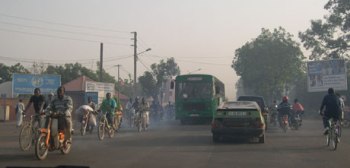The doctoral thesis titled ‘Urban Climate and Air Pollution in Ouagadougou, Burkina Faso’ submitted by Jenny Lindén from the Department of Earth Sciences at the University of Gothenburg demonstrates that climate conditions of a city lend to increased levels of pollution. It also claims that improved awareness about pollution assists in controlling and restoring climate conditions.
 The air quality in Ouagadougou is very bad
The air quality in Ouagadougou is very bad
The research finds that most of the population occurs only in poor cities, which in turn has a bearing over the air quality and urban climate. It has found that the population in Ouagadougou, a city in western Africa close to Sahara Desert, is growing rapidly and anticipated to reach an alarming level of 3.4 million in 2020 from its current level of around 2 million.
According to a report from World Health Organization, around 20% of all deaths in Burkina Faso occurred due to respiratory problems caused by air pollution and the percentage will go up due to increasing levels of population.
Ouagadougou suffers from increased level of pollution due to dusty winds blowing from Sahara Desert and dust generated from the unpaved roads. The country has a good number of old and badly maintained cars and two wheelers and nearly three-fourth of families cook food using an open fire. Rich people who live in cities are not much exposed to pollution; they use new vehicles, have paved roads and use non-polluting modalities to cook food. Ouagadougou‘s situation is similar to other poor cities in the world.
According to Jenny Lindén, Ouagadougou has a typical climate with lower level of temperatures during night at areas with good amount of vegetation, which can be considered as an efficient way to reduce night-time heat stress in city planning. The air over Ouagadougou stay static and pollutants occurring during the evening hours trap the emissions. These studies can be used to plan strategies to enhance the air quality in poorest countries of the world.